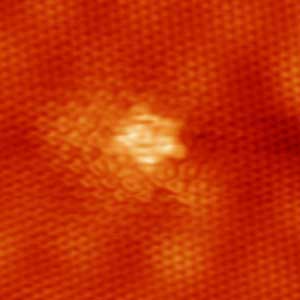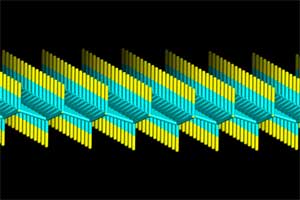Graphene Printing Press
It's been a year since Konstantin Novoselov and Andre Geim won the Nobel Prize in Physics for their breakthroughs with graphene, and only a few years since they first made headlines by sticking carbon to strips of scotch tape and isolating it into a one-atom thick layer.

Ultra-high vacuum scanning tunneling microscopy image of a point defect in graphene.
Image courtesy of Nathan Guisinger, EMMD Group, Argonne National Laboratory

Novoselov told an audience that the most interesting applications would come not from graphene itself, but from layers of graphene with other single-atom thick materials. The image above is of bilayer fluorographene.
Graphene is the world’s strongest and thinnest material and one of the most active areas of science and yet, it’s been called an incredible substance looking for an application.
While graphene has obvious applications in modern electronics, many physicists haven’t expected the material to be of practical use in the near future.
Its competitor, silicon, is cheap and has been heavily studied and used. Graphene is also incredibly difficult to make in anything but the smallest quantities.
Most have seen the likeliest applications being things like flexible touch screens and more-efficient batteries.
Now, the same physicists who won the Nobel Prize in 2010 for their breakthroughs in using the substance have found an application that could produce computers capable of operating at near the speed of light.
The pair discovered that the new material has incredible electronic properties. It can conduct electricity 30 times faster than silicon.
In a lecture at the American Physical Society’s March meeting, Novoselov told an audience that the most interesting applications would come not from graphene itself, but from layers of graphene with other single-atom thick materials.
He delivered on the claim several months later by publishing a study that details the electronic properties of so-called bilayer graphene.
Now, companies like IBM, Samsung and even the US Navy are looking to implement graphene technology.
The use of single-layer graphene is limited to materials that don’t require the ability to stop and start the flow of electrons, like a foldable cell phone. By suspending the bilayer graphene in a vacuum they were able to control the flow of electrons.
That could lead to transistors, considered the building block of modern electronics, made with the substance. One study indicates there could be as many as one billion transistors produced each year for every person on Earth.
IBM is currently researching how they might implement graphene technology to make more efficient cell phones with better reception and the Navy might take advantage of it to achieve superior radar capabilities.
Meanwhile, at the Massachusetts Institute of Technology (MIT), physicists are trying to approach the problem of making graphene from a more industrial angle.
The largest sheet ever produced was about a 30-inch square.
Tomas Palacios, director of the new-born Center for Graphene Devices and Systems at MIT, says he plans to create a printing press for graphene based on the same technology now used to make newspapers.
If the new center is successful, they will have the basic technology required to print a 1-kilometer sheet of graphene and could help launch an entire industry based off this revolutionary material.














